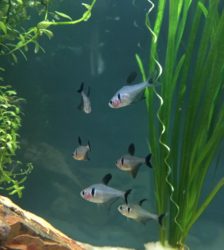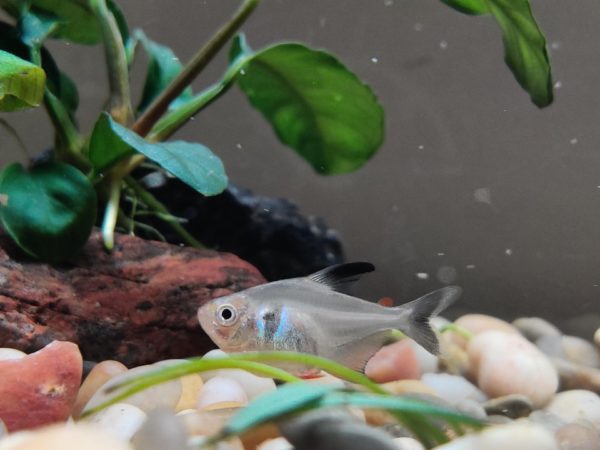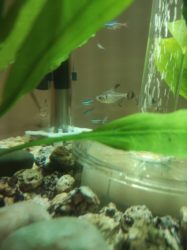Table of Contents
Black Phantom Tetra: A Brief Introduction
Black Phantom Tetras are small, black fish with elongated bodies and red eyes. They are native to South America and thrive in warm, heavily-planted tanks with dim lighting. They are a peaceful species and can be kept with other peaceful fish.
Black Phantom Tetra Overview
Hyphessobrycon Megalopterus also commonly referred to as Black Phantom Tetra is a freshwater fish that is popular amongst aquarists. The fish belongs to the Characidae family and they are usually distinguished with their unique tiny adipose fin that is located in between their dorsal fins and caudal fins. Black Phantom Tetra are easy to keep in home aquaria because they easily adapt to habitat change without much of a hustle. It has got a total of four fins that are the unpaired reason for their name tetra. The four fins that the fish has are the anal fin, caudal, adipose, and dorsal fin.
Appearance of Black Phantom Tetra

Just like most other species of tetra, the black phantom tetra has a rather flat body with a longer dorsal fin. The tail of the fish is somewhat forked at the end allowing for its easy identification. The male phantom tetra has a shape that is almost tetragonal but the coloring of the male is not as bright as that of the female. You will easily distinguish a male from the female by taking a look at its coloring which is more grayish. The male also has got a dark patch that is located behind the gills.
The female of the fish have got a pelvic fin that exhibits a natural reddish hue. This is also evident in their caudal and anal fins. The male black phantom tetras don’t have any reddish coloration on them. Again a keen look at the fins of the females and you will realize that they have fins that are shorter and smaller compared to those of the males. Another striking feature of the females is their dorsal fins which are blacker than those of the males. During breeding, you will see that the females tend to have bodies that are plump.
Habitat
Black Phantom Tetras have their origins in the South American region specifically between the Bolivian and Brazilian border. They were originally found in the river basins of Rio Mamore and Rio Beni. In Bolivia they were originally found in the Rio Guapore. The fish have a rather large distribution in the wild and currently there is no cause for alarm to their continued existence. They are easily available and thus you will find them affordably in pet stores without much of a hustle.

In the wild the fish is known to like living in densely vegetated areas and therefore when it is to be kept in an aquarium setting the tank need to be furnished with sufficient freshwater plants.
Temperament and Behavior of Black Phantom Tetra
The black phantom tetras are social creatures and prefer to stay in specific groups. They are not some schooling species, but the shoaling fish sticks together in groups for most of their time. Most times, this fish is not aggressive at all. However, the male fishes at times try to show territorial behavior over time. This type of fish often develops a social hierarchy within a group. The males, at times, creep into someone else’s territory and have to take up a mock fight.
At the mock fights, the male fishes will be acting aggressively to one another. They might do the mirror movements or swim around to give an interesting display. Mock fighting is not for injuring one another but is an innocent behavior of these fishes.
Tank setup for Black Phantom Tetra
The Black Phantom Tetra is highly hardy and this is one thing that makes it a popular favorite of many aquarium enthusiasts. The fact that the fish is very resilient makes them also a great option for beginner aquarists. The fish is known to perfectly adapt to abrupt water changes will readily survive even in community tanks. One thing to note though is not to mistake the high resilience of the fish with ignorant care. Just like most other fish kept in the aquarium ensure that the tank is kept clean at all times. You can ensure this by removing food debris that is left by the fish in the tank. Performing frequent water changes is also advisable as this will reduce the possibility of causing infection in the tank.

Tank Requirement
Here below are some basic care tips that you can follow when setting up a tank for the Black Phantom Tetra:
- The fish are highly active swimmers and therefore need a tank that is longer in length. Ensure that the tank is at least 20 inches.
- The tank should also be big enough for the fish because they are a schooling kind of fish. A tank with a water capacity of at least 29 gallon is good to go.
- Ensure that the tank water is soft and have peat-filtering installed on the aquarium.
- Due to the swimming nature of the fish ensure that the center of the tank is open enough. You can have plants to the sides and back of the tank. The fish are quite choosy and will be dull in a tank that is not properly arranged.
- As for the substrate to be placed on the bottom of the tank, it is best to use dark-colored substrate such as Carib Sea Eco-Complete.
- Ensure that it is dimly lit so that the fishes’ attractive coloration can be highlighted.
- Have a lid tightly placed on top of the tank because the fish are notorious jumpers and will easily jump out of the tank.
- The pH range for the tank water should be at least 6.5 with a hardness range of 10dGH.
- Ensure that the water movement is moderate. Perform a thirty percent water change each week for heavily populated tanks.
Water Temperature
The black phantom tetras prefer to live in tropical river conditions. They are ideal to be kept in biotope tanks. The biotope tanks are set up to replicate the water chemistry, similar to the natural habitat. This species of fish mostly dwells in a slow-moving flow of water. It is better if the water has plant life in it. Dense vegetation and decaying plant matters are necessities for making the water-rich with nutrients.
Black phantom tetras do have the potential to adapt to almost all conditions. Still, to ensure that the water temperature is right, you should determine that the range should be between 72 degrees F to 82 degrees F. This is the ideal temperature range for keeping your tetra at a home aquarium. One or two points up or down might not create a big hassle. But anything beyond that is going to raise care concerns for the tetras.
Feeding Black Phantom Tetra
The fish is an omnivorous fish that essentially feeds on both plants as well as tiny animals. In the wild, the fish is known to feed on tiny insects, crustaceans, and worms. When you are going to keep them in a captive environment, feed them food they eat in the wild. Fortunately, they can also be fed fish flake food as well as micro pellet feeds. These are some of the most easy to feed fishes you will find in the aquarium hobby today.

Black Phantom Tetra Breeding
The Black Phantom Tetra is prolific breeder with the female capable of producing up to three hundred eggs. With optimum aquarium conditions the fish will breed easily. You can facilitate the breeding process of the fish by manipulating the pH of the tank water to about 5.5 or 6. You will also need to make the hardiness of the water to be dH4. For stress free breeding, it is best to have a single male with a group of females in the same tank. A single male should be able to fertilize the eggs of the many females it will be placed with on the same tank.
Disease Potential
Black Phantom Tetras are quite susceptible to all types of common health issues that a fish suffers from. Some of such issues include bacterial infections, Ich, parasites, and flukes. However, with ideal care, you can seek to avoid most of these diseases. You need to go ahead with a 25% water change every week to ensure that the ammonia levels in the water are down. Hence, this will help you maintain the optimality of water for the healthy living of the fish.
Apart from that, you must also take proper care upon water cycling the tank. Before you add any new plants or fish to the aquarium, you need to quarantine them to ensure that they don’t get aggressive right from the beginning. It is to play the things safe, as you do not want your existing fishes killing off the new ones. If they are introduced to any closed ecosystem with some additions, the black phantom tetras are prone to parasites and diseases.
It means that you need to be careful throughout changing water or bringing in new fish or plants to the tank. It is because your negligence might just expose your fish to parasites or diseases. Some of the disease symptoms are not prominent before a week or two that will end your time to react and respond to revive the health of your fish. And that will eventually result in their death!
FAQs
How do you take care of a Black Phantom Tetra?
You can take care of black phantom tetra by setting up a well-planted tank. You can prefer to add floating plants to the aquarium if you are willing to pet this fish. You can also consider adding up some dried leaves in your tank. You can also consider adding driftwood in the tank to give them a better space to wander around. In addition to that, you should also change water frequently, as this species of fish cannot resist poor water.
Are Black Phantom Tetra Hardy?
Black Phantom Tetra Hardy is highly hardy! And this is one attribute that makes it quite popular amongst aquarium enthusiasts. The fish is also resilient, which makes it an ideal option for beginner aquarists. This fish also can adapt to water changes and can survive within the community tanks. But high resilience should not trigger your ignorant attitude towards this species.
How long do black phantom tetras live for?
Black phantom tetra has a lifespan of 5 years. Some fish of this species can also live for around six years if you take ideal care of them and are a bit lucky. Therefore, make sure that the care quality you offer them will decide upon the life expectancy of your fish. Get them optimal water, a perfect environment, and a healthy diet to help them thrive with a healthy life.
How big do black phantom tetras get?
The size of black phantom tetra varies depending upon the varieties. If you own a long-finned variety developed and maintained by captive breeders, it has the best size and is often sold in the aquarium trade to obtain the best size. The male black phantom tetras do have a bit elongated anal and dorsal fins. The standard lengths that the black phantom tetras grow are 3.6cm or 1.4inches.
Why are my black phantom tetras fighting?
The fighting behavior of the black phantom tetras is normal. If the tank is pretty much small, then it will hamper their space of rest. It becomes stressful for them, and they begin to fight one another throughout the day. Many tetras are peaceful and never fight within the aquarium. If you feel like your tetras are very aggressive to one another, you can prefer to change them after a day or two by observing how they react to your tank environment.
Can black phantom tetras live with bettas?
Black phantom tetras can be good mates with bettas in the same tank. One reason these two are the best mates for living in one tank is that phantom tetras have black neon color. And that doesn’t trigger the bettas against them. Color is the key for triggering aggression in fishes, and that aspect is neutralized here. Apart from that, both tetras and bettas need the same parameters to survive. Hence, they can be good mates in an aquarium tank!
Can black phantom tetras live with angelfish?
Black phantom tetras and diamond tetras are quite small and can go well with that of the angelfish. The bigger tetras, such as serape tetras, neon tetras, and black tetras, are bigger and might nip angelfish fins. Therefore, it is better to go for small tetras to keep them in the same tank as angelfish. As black phantom tetras are smaller, they are fast to dodge even if the angelfish comes close. In this way, they can also share the same water roof without much hassle.
